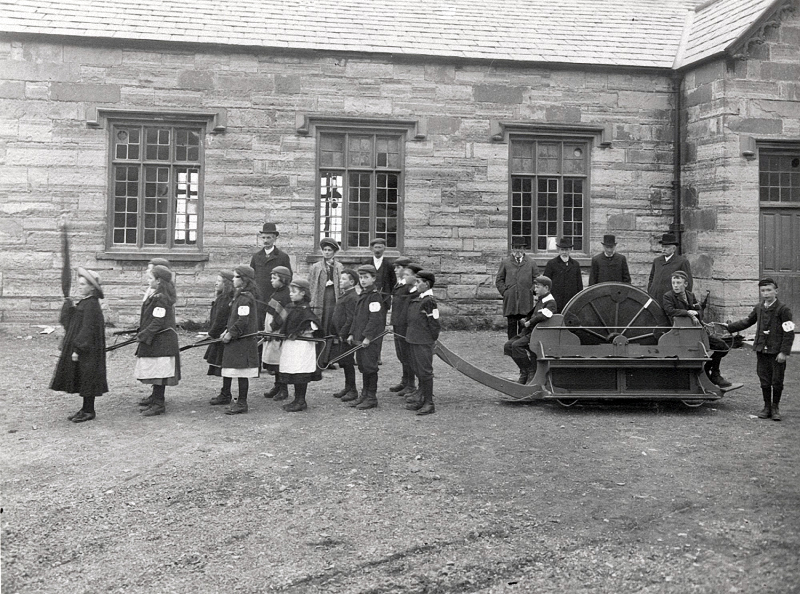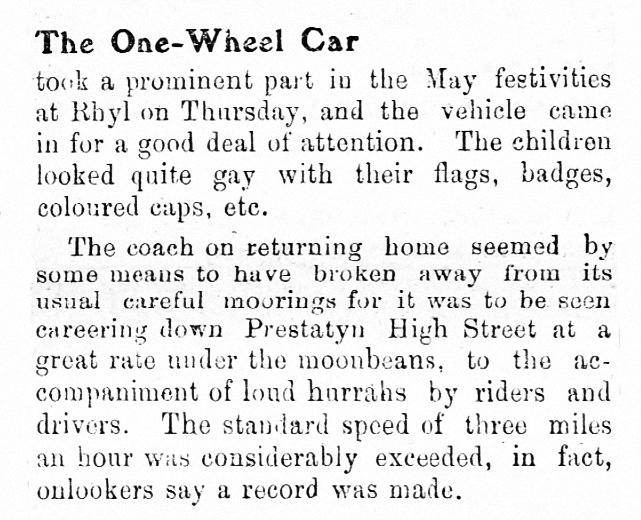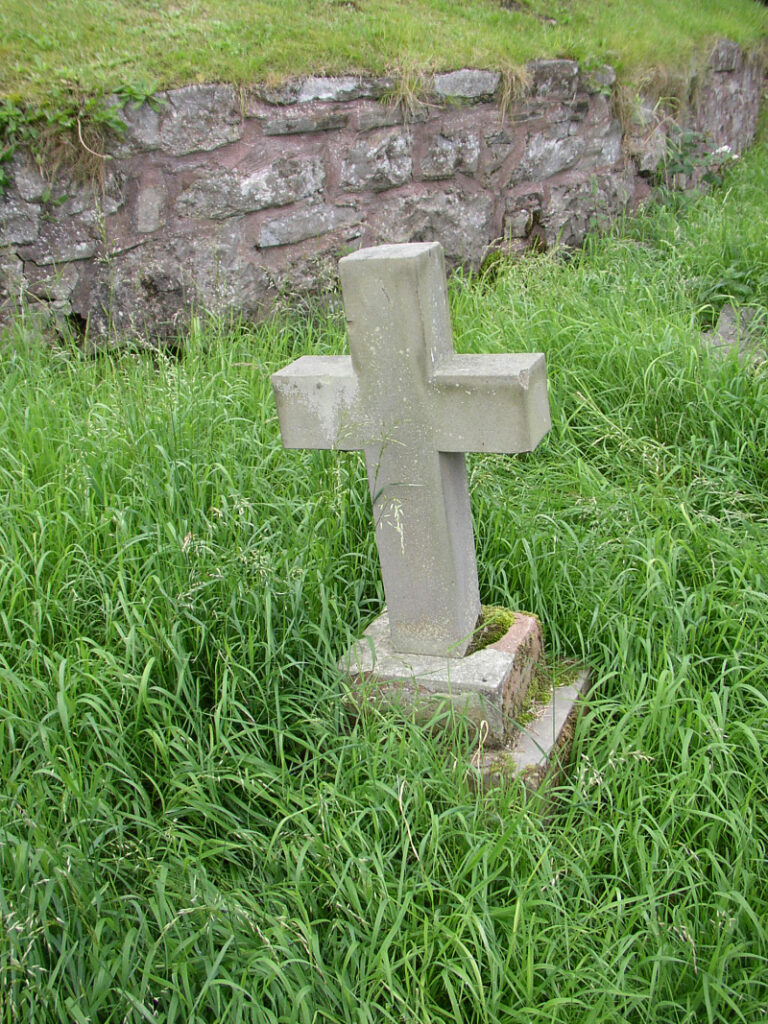
This is the only photograph that I have ever seen of the Meliden One-Wheeled Coach. It was taken in front of the Meliden National School some time between 1905 and 1907 for the Strand Magazine by J. Burrows, the Prestatyn stationer, photographer and printer. Eleven children provide the motive power and they are preceded by a girl bearing a flag. There are two passengers accompanied by a “guard.” The adults looking on include the Headmaster, Mr Thomas Owen who is standing on the left. The sinister looking man standing behind the single wheel is Peter Williams, the machine’s creator.
Peter Williams was the son of a Holywell registrar surgeon who started his career in St. Pancreas as an engineer’s clerk. From 1861 he lived in Birkenhead, working as a land and building surveyor and then in the 1870s he lived in Tranmere with his sister Mary who kept house. Within a decade he had returned south to Croydon. After retirement in 1901 he lived in Pendyffryn (Next to Melyd Lodge) with his sister. He was well known in the village as a Church warden and for his forthright defence of the Church during the campaign to end the Church of England as the Established Church in Wales.
The One-Wheeled Coach was first mentioned in the Prestatyn Weekly on 9th September, 1905:
‘A new conveyance designed by Mr P. A. Williams, Maes Melyd, is about to be placed at the disposal of the children in the village. The vehicle will be peculiar in that it will have but one very large central wheel, the motive power being supplied by a team of boys hitched to a shaft or pushing bar. A dozen passengers, including driver and guard, can be accommodated, and one of the features claimed for the conveyance is its safety, for the children will be but a matter of a few inches from the ground. The coach will have to be correctly balanced, and will be provided with “skids” on either side. Mr G. Williams, Penrhwylfa, has almost completed the car, and it is expected a trial trip will be made about the 23rd instant.’
He wrote to the Prestatyn Weekly, explaining that it was for the amusement of the children of Meliden School.
‘…. the Coach in itself simply acts as a means to an end, its intention being an attractive method for organizing a Children’s Open-air Choral Union, and so enlivening our small village with harmonious song.’
The test run took place on Ffordd Penrhwylfa at the end of September but for some reason Peter Williams did not accompany the children and the coach came back damaged. The children explained that during the outing, they had met up with ‘a young butcher and his friend,’ who by force or favour had taken vehicle which they crashed through a hedge and into a ditch.
Using children may have been a problem for what we would these days call health and safety reasons. Even in 1905 there was some concern and according to the Prestatyn Weekly, the managers of Meliden School asked permission of the Education Committee to allow the children to use a “drill machine.” The committee was not satisfied as to what the “machine” actually was, and refused. Peter Williams clarified the position by writing a letter to the Prestatyn Weekly, explaining that the managers of the school had never asked permission from the County Education Committee because they had no need to. The fact was that he had as “Manager” applied for a certificate of safety so as to use the one-wheel car on the public highway. Somehow, that certificate had been sent to the Director of Education who laid it before his committee as an “application for permission” to use the vehicle. He ends his letter to the Editor with an exercise in publicity.
‘This open-air drill coach for school children must remain a so-called “Mystery,” until its counterpart is discovered amongst the tens of thousands of elementary schools throughout the United Kingdom. So far it bears the palm as being the only one of its kind, which can take a load of 12 small children, drawn by their 10 or 12 playmates, along the public roads at a rate of 6 or 7 miles an hour. The eagerness of the little pulling team, and the scramble of the little ones for their passenger seats, is an eloquent testimonial to the entire turnout. All I can say to the thousands of other elementary schools is, “Go and do likewise.”‘
By the end of October, the teething troubles appeared to be over and Peter Williams felt confident enough to announce, ‘The Meliden “One-Wheeler” will, weather permitting, be paraded through Prestatyn on Saturday afternoon, thus giving all an opportunity of inspecting this car of novel construction.’
The “Mysterious” vehicle became a regular sight in the area as it could be seen journeying quite regularly to Rhyl completely under the power of small school children. Weighing 4 hundredweight (303 Kg) it was hardly lightweight yet it was propelled at speeds between 7 and 9 miles per hour. This was reduced to 3 miles per hour in a strong headwind but was maintained for a 4½ mile stretch on one journey to Rhyl. The inventor was certain that this could never be done with an ordinary 4-wheel vehicle of the same weight. A one wheeled vehicle experiences less friction and the apparent instability was overcome by having two skids on either side which skimmed at about one or two inches above the road. It created an effect something like the behaviour of a pebble thrown across the surface of a pond.
The Children’s Choral Brigade took their One-wheeler to the Rhyl May Day Demonstration of 1905 and won the Special Certificate of Merit for being the ‘Most Original and Ingenious Turnout in the Whole Procession,’ The children may have been very excited but once tucked up in bed and without their knowledge, the grown-ups had some fun of their own. The Prestatyn Weekly explained;

The fame of the Meliden Carriage spread nationwide. In October 1907 it appeared in the Curiosity Column of the famous Strand Magazine, hence the unique photograph.
The One-Wheeled Car remained a novelty for the next three years or so and often used in village races but never won the approval of the Flintshire Education Committee. It continued to win prizes at the Rhyl May Day Parade as Most Original and Ingenious Turnout in the whole Procession with special certificates of merit in 1908, 1909 and 1910. It was crewed in rotation by twenty or thirty children, dressed with brightly coloured sashes, under the captaincy of Mr J E Thomas. Fitted out with rigging and adorned in flowers, it always delighted the crowds, yet, sadly, always seems to have eluded photographic record.
Like blazers, flannels and straw boaters, the One-Wheeler was very much of its time and as the Indian Summers of the Edwardian slipped away, so too did the inventor. He died on 17th March, 1911, less than two months before the king. If you want to visit Peter Williams’s grave, take a walk down to the lower churchyard and after going around the bend to where the railings end, look right, his grave is the fifth row, fourth in. The cross is down now. [Not far away is the grave of the man who had faith in the scheme, Thomas Owen, the headmaster of Meliden School. It is next to the house wall – in the middle.]

‘The Funeral of Mr P A Williams
The death took place on Friday last at Maes Melyd, Meliden, of Peter Arthur Williams aged 83 years, and on Tuesday the internment took place at Meliden Churchyard.. The deceased was by profession a shipping engineer, and in many ways he displayed great ingenuity. He was the the patentee of what is known as “The One Wheel Coach,” a contrivance which has been exhibited on many occasions by the Meliden School children. The idea, however, does not seem to have advanced beyond the locality, although the deceased had a strong faith that the principle he had evolved would be taken up widely ………………….
The obituary goes on to describe something else and that has its own story. That story is called The Coffin!
